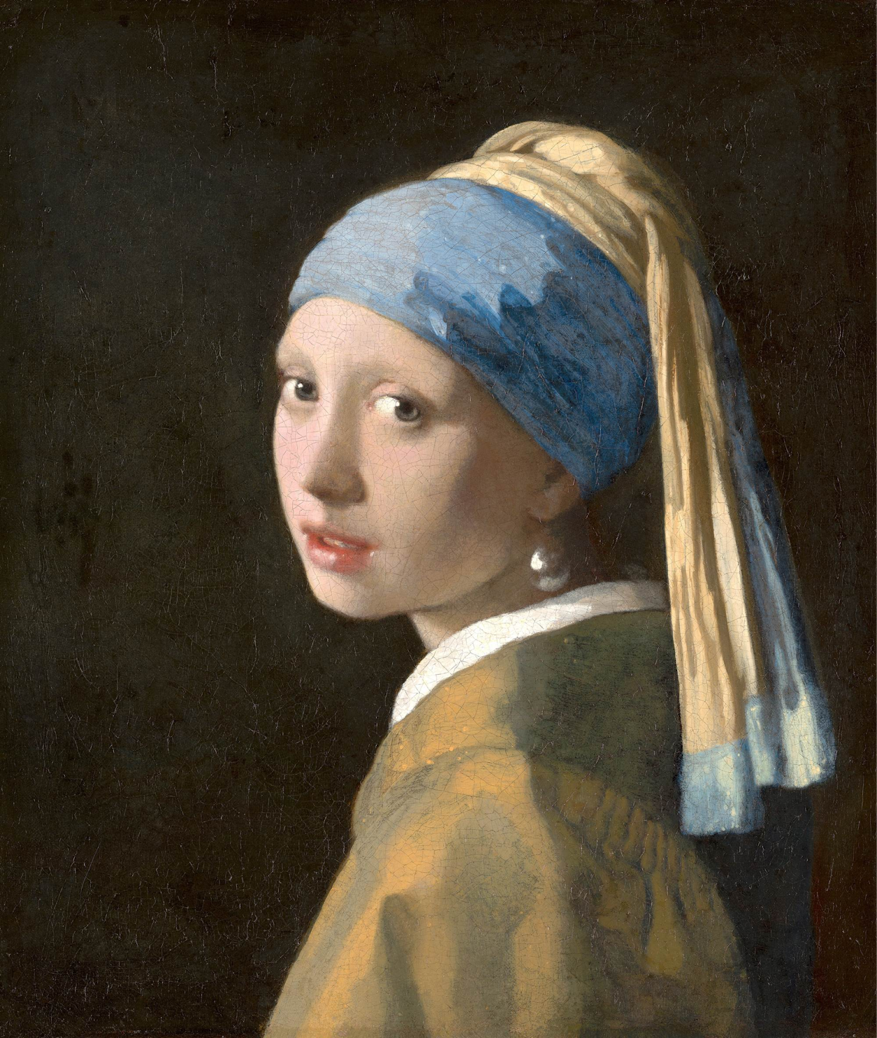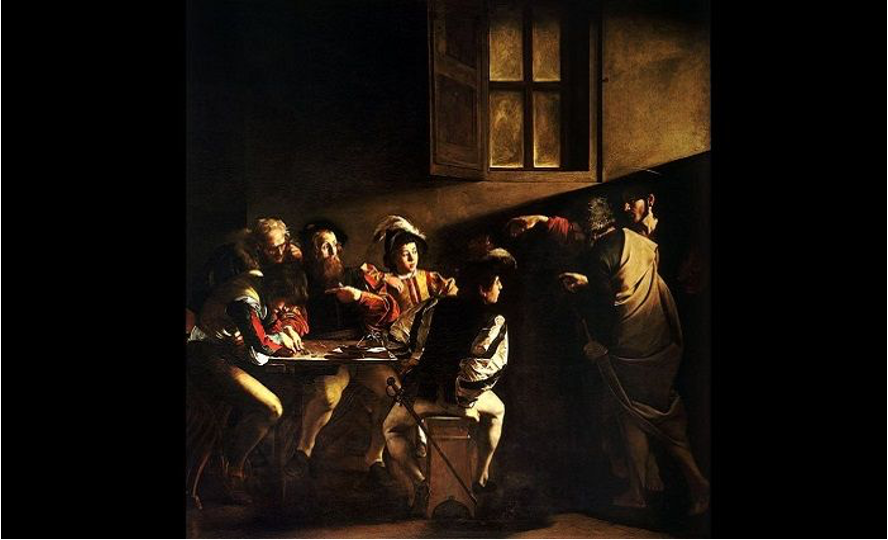1. Introduction
How can paintings in the same style category be different from each other? This paper will explore two famous paintings from the 17th century that are both baroque styles. One is called Girl with a Pearl Earring painted by Johannes Vermeer, and the other is called The Calling of Saint Matthew, painted by Caravaggio.
Johannes Vermeer is one of the most well-known Dutch painters of the seventeenth century. He is well-known for his intimate domestic settings, which feature stunning lighting. Vermeer's other works, such as the well-known Girl with a Pearl Earring and View of Delft, achieve a peaceful, almost timeless feel. Vermeer often depicted women doing everyday household tasks, such as cooking (The Milkmaid) or reading letters (Women Reading a Letter). These meticulous duties highlight the beauty and dignity of everyday living. There is a sensation of spending alone time when these moments are highlighted.
Since Vermeer always spent a long time on every painting, he did not complete many paintings. So it is not surprising that we only know 36 paintings by him. He painted Girl with a Pearl Earring around 1665. The painting focused on the portrayal of a girl wearing pearl earrings. The main themes are mystery, beauty, the symbol of wealth, and facial expression. It represents a young woman in a dark space, who wears a blue and gold turban, an improbably large pearl earring, and a gold jacket with a visible white collar beneath. Unlike many of Vermeer’s objects, she is not concentrating on a daily chore and is unaware of her viewers. Rather, as if capturing a moment in time, she turns her head over her shoulder and meets the viewer's gaze, her mouth slightly parted as though she were about to speak. Some have drawn comparisons between her and the grin of the Mona Lisa due to her enigmatic look and the mystery surrounding her identity.
Painted by Caravaggio, The Calling of Saint Matthew conveyed an image of Jesus calling the tax collector Matthew. Using the technique of contrasting light and dark, Caravaggio emphasized the acceptance of new life and the awakening of realization. Caravaggio uses earthy tones and deep shadows, and his color scheme is mainly soft and gloomy. This mood represents Matthew's departure from a world of sin and moral uncertainty. The highlights of light yellow and white draw the audience’s attention toward the main subject. Split aside all the unimportant lesser parts. The warm tone of the color shown in the sunlight and the main character’s faces give people a sense of hope and enlightenment.
Both paintings use techniques of light to deepen the story and emotions conveyed through the vision, but they do it in unique ways that represent their different creative philosophies and historical settings.
2. Background information
The Dutch Golden Age (17th century) was a period of economic, cultural, and artistic prosperity for the Dutch Republic (then known as the "United Provinces"). During this period, the Netherlands broke away from Spanish rule and gained independence through the Eighty Years' War (1568-1648), establishing a relatively free republic. During this period, the Netherlands became one of the wealthiest countries in the world through maritime trade, navigation, colonial expansion, and financial industry. As the economy prospers, the appreciation of art increases too. The middle class is the major supporter of the pursuit of art area. They led to a new area of art that involves more personal, smaller-scaled scenes. Besides, merchants also accelerated the trade among famous artworks, those who sought to express their social status often chose to purchase impressive, talented artworks. Excluding simple decoration, there are investors who have found potential in some artworks and have chosen to keep them for future economic value.
The middle of the 17th century was a special period when Dutch culture and art gradually lost their original cultural characteristics. The rising capitalist system in the Netherlands provided people with more democracy and freedom as if spring rain had revitalized the ground and woken everything. This also forces art to rely on the bonds of religion and the court while confronting secular society more broadly. To appeal to the aesthetic tastes of the bourgeoisie and citizens, painters give more attention to the portrayal of life's intricacies. "Little Dutch Painter" was born in such an environment, and Vermeer is one of its representatives.
In terms of the style of the artists at that period, it was precise, focusing on realism and naturalism. Artists focus on the use of light, color, and detail to convey a feeling of realism in life. Visual effects are often enhanced through strong contrast, sportiness, and dramatic lighting treatments.
Baroque art (17th century to early 18th century) emerged in many European countries, particularly in Catholic powers such as Italy, Spain, and France. The rise of Baroque art is closely related to the Reformation and the Catholic Counter-Reformation. In the late 16th century, the Catholic Church sought to counter Protestantism's impact by launching the Counter-Reformation movement, which used art to preach religious teaching and win disciples. As a result, Baroque art emphasizes emotional expressiveness, religious commitment, and visual impact. Art during the Baroque period also received strong support from monarchies, especially in France where Louis XIV was an important patron of Baroque art. Palace art played an important role in the Baroque period, with architecture, sculpture, and painting often used to showcase the greatness and majesty of royal power.
3. Analysis of Girl with a Pearl Earring
Vermeer likes to use yellow, blue, and gray. His understanding of color and light processing is exceptional. Typically, the layout is basic and the size is tiny, but it has a significant visual effect. He is recognized as the master of light and shadow because he utilizes a mixture of small dots (dot painting) and is adept at harnessing light sources to create a fluid and graceful ambiance in his paintings.
According to the article: Women in Vermeer’s Home: Mimesis and Ideation, Author: H. Perry Chapman, “In the emergence of domesticity around 1650, paintings were just as likely to shape values as to reflect them [1-3]. It suggests ways to situate Vermeer’s artistic personality and its reception within society.” The emotional expression of Vermeer’s women is often interpreted. They may seem lost in thought such as Girls with a Pearl Earrings. Vermeer is good at finding the rare moment that the girl expresses her emotions in depth and complexity, which is delicate and mysterious.

Figure 1: Girl with a Pearl Earring
4. Analysis of The Calling of Saint Matthew
In The Calling of Saint Matthew, Caravaggio employed a variety of light and shadow techniques, including chiaroscuro, which is a key element of Baroque painting as well as an indication of the artist's own style. Caravaggio is recognized for his meticulous attention to realistic detail. His use of light and shadow improves both the drama and the scene's believability. The use of light highlights details such as the actors' expressions, skin texture, clothing folds, and money on the table, giving the spectator a very lifelike impression. This feeling of reality humanizes the hallowed situation, allowing the audience to empathize with Matthew's astonishment and uncertainty [4].
The light shines into the room from the upper right corner of the picture, directly illuminating the face and hands of Jesus, and then shining on Saint Matthew. This beam of light not only brings visual focus but also gives the scene dramatic tension, making the viewer immediately notice the moment of the sacred call. The sudden exposure of light and the contrast of darkness highlight the moment when Matthew transforms from daily secular life to sacred mission. So, what are some effects that the light brought to this painting? Light often symbolizes divine power and revelation in Caravaggio's works. In The Calling of Saint Matthew, this beam of light is seen as a symbol of God, representing Jesus leading Matthew from sin to salvation. Matthew's initial confusion and surprise are also highlighted by the illumination of light, and his transformation from an unjust tax collector to a disciple of Christ is perfectly presented in the transition of light and shadow. The light not only directly lights Jesus and Matthew, but it also indirectly leads the viewer's gaze. Other people look more blurry against the black backdrop, however, Jesus' motions and Matthew's pointing actions are focused at the intersection of light. This arrangement naturally directs the viewer's gaze to the essential individuals and movements lit by the light. Caravaggio's excellent use of light converted a motionless religious scene into an emotional and tension-filled moment, representing both the lofty religious topic and the characters' complicated inner lives.

Figure 2: The Calling of Saint Matthew
5. Comparative analysis
There are both similarities and differences between these two paintings. The choice of subject, use of light, and composition may seem really different yet they do have things in common.
It is common that both Vermeer and Caravaggio are masters in terms of light usage, they used different techniques of light to reach certain goals. Vermeer used gentle light to express the details on the person’s face, to encourage audiences to emphasize. Caravaggio used intense light to highlight the religious atmosphere in the painting, raising the intensity of the audience about the witness of the divine. Both paintings used light to highlight the main topic. With a dark backdrop and an illuminating subject, the viewer can quickly identify what is being highlighted in this artwork. While The Girl with a Pearl Earring simply highlighted the subject, The Calling of Saint Matthew focused on how light carried messages. The light on Matthew and Jesus revealed their relationship to God, with Matthew becoming spiritually awakened by Jesus' guiding light [5].
Both paintings focused on the conveyance of human emotions. The girl in Vermeer’s painting remains mysterious and enigmatic, drawing the audience’s attention to being curious about her identity. The characters in Caravaggio’s painting were clear in the transformation of the identity from tax collector to a follower of Christ, which highlighted the sudden emotion of awe, surprise, and faith.
6. Conclusion
The art of the Dutch Golden Age reflects a society characterized by economic prosperity, rapid urbanization, and relative religious freedom, emphasizing realistic depictions of daily life and attention to detail. The art of the Baroque era was deeply influenced by religion and politics, with strong emotions, dynamic composition, and the use of contrast between light and dark as its prominent features, mainly serving the needs of religion and the court. The arts of these two periods have their own characteristics, but both enhance emotions and narrative effects through the unique use of light, reflecting the cultural and social characteristics of their respective eras.
References
[1]. GASKELL, IVAN. “Valuing Vermeer.” Studies in the History of Art, vol. 55, 1998, pp. 8–17. JSTOR, http://www.jstor.org/stable/42622595.
[2]. Filipczak, Zirka Z. “Vermeer, Elusiveness, and Visual Theory.” Simiolus: Netherlands Quarterly for the History of Art, vol. 32, no. 4, 2006, pp. 259–72. JSTOR, http://www.jstor.org/stable/20355337.
[3]. Chapman, H. Perry. “Women in Vermeer’s Home: Mimesis and Ideation.” Nederlands Kunsthistorisch Jaarboek (NKJ) / Netherlands Yearbook for History of Art, vol. 51, 2000, pp. 236–71. JSTOR, http://www.jstor.org/stable/24706498.
[4]. SALOMON, NANETTE. “From Sexuality to Civility: Vermeer’s Women.” Studies in the History of Art, vol. 55, 1998, pp. 308–25. JSTOR, http://www.jstor.org/stable/42622615.
[5]. Baroque as a problem: Hassold, Ernest C. “The Baroque as a Basic Concept of Art.” College Art Journal, vol. 6, no. 1, 1946, pp. 3–28. JSTOR, https://doi.org/10.2307/773561.
Cite this article
Huang,Y. (2025). Color and Light: Analyzing the Relationships Between Girl with a Pearl Earring and The Calling of Saint Matthew. Lecture Notes in Education Psychology and Public Media,92,30-34.
Data availability
The datasets used and/or analyzed during the current study will be available from the authors upon reasonable request.
Disclaimer/Publisher's Note
The statements, opinions and data contained in all publications are solely those of the individual author(s) and contributor(s) and not of EWA Publishing and/or the editor(s). EWA Publishing and/or the editor(s) disclaim responsibility for any injury to people or property resulting from any ideas, methods, instructions or products referred to in the content.
About volume
Volume title: Proceedings of the 3rd International Conference on Social Psychology and Humanity Studies
© 2024 by the author(s). Licensee EWA Publishing, Oxford, UK. This article is an open access article distributed under the terms and
conditions of the Creative Commons Attribution (CC BY) license. Authors who
publish this series agree to the following terms:
1. Authors retain copyright and grant the series right of first publication with the work simultaneously licensed under a Creative Commons
Attribution License that allows others to share the work with an acknowledgment of the work's authorship and initial publication in this
series.
2. Authors are able to enter into separate, additional contractual arrangements for the non-exclusive distribution of the series's published
version of the work (e.g., post it to an institutional repository or publish it in a book), with an acknowledgment of its initial
publication in this series.
3. Authors are permitted and encouraged to post their work online (e.g., in institutional repositories or on their website) prior to and
during the submission process, as it can lead to productive exchanges, as well as earlier and greater citation of published work (See
Open access policy for details).
References
[1]. GASKELL, IVAN. “Valuing Vermeer.” Studies in the History of Art, vol. 55, 1998, pp. 8–17. JSTOR, http://www.jstor.org/stable/42622595.
[2]. Filipczak, Zirka Z. “Vermeer, Elusiveness, and Visual Theory.” Simiolus: Netherlands Quarterly for the History of Art, vol. 32, no. 4, 2006, pp. 259–72. JSTOR, http://www.jstor.org/stable/20355337.
[3]. Chapman, H. Perry. “Women in Vermeer’s Home: Mimesis and Ideation.” Nederlands Kunsthistorisch Jaarboek (NKJ) / Netherlands Yearbook for History of Art, vol. 51, 2000, pp. 236–71. JSTOR, http://www.jstor.org/stable/24706498.
[4]. SALOMON, NANETTE. “From Sexuality to Civility: Vermeer’s Women.” Studies in the History of Art, vol. 55, 1998, pp. 308–25. JSTOR, http://www.jstor.org/stable/42622615.
[5]. Baroque as a problem: Hassold, Ernest C. “The Baroque as a Basic Concept of Art.” College Art Journal, vol. 6, no. 1, 1946, pp. 3–28. JSTOR, https://doi.org/10.2307/773561.









